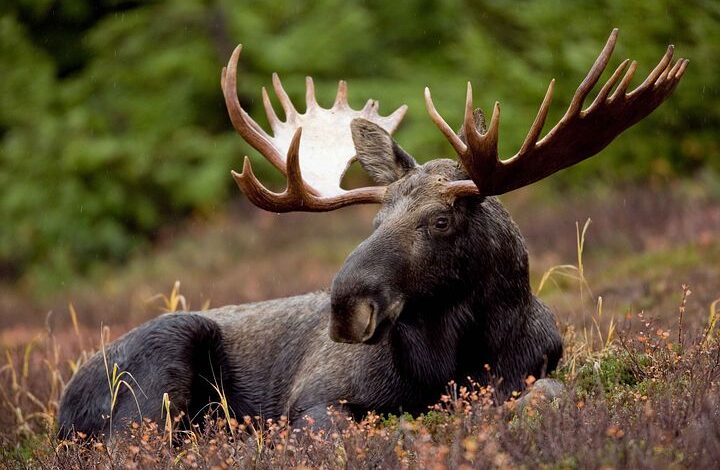Moosegazete: The Majestic Mammal of North America

An unfamiliar mammal species native to North America and Canada is the moosegazete. Despite being a member of the deer family, it distinguishes itself with its powerful bellowing vocalizations. As a colossal herbivore, it relies on its impressive antlers or prominent horns for protection.
The type of moose I’m discussing might intrigue those with an interest in discovering lesser-known deer species. Those unaccustomed to the company of such plant-eating animals might be taken aback by their piercing snorts. The moose has held its reign over the wilderness since ancient times, boasting an unconventional appearance.
Though moosegazetes and deer share kinship, they exhibit several notable disparities. Their stature is substantially larger with elongated legs compared to typical deer. Their substantial legs enable them to traverse snowy terrain more adeptly. Notably, their tail lacks the bushiness seen in conventional deer tails.
Remarkably, it can grow antlers that extend up to six feet in length. These antlers function as the moose’s means of defense against both humans and other creatures. During the mating season, they also employ these antlers to allure potential partners. Preferring solitary habitats such as marshes, woodlands, and mountains, they predominantly graze on leaves and grass.
What is Moosegazete?
The moosegazete, the grandest of deer species, attains a height of six feet (1.8 meters) from hoof to shoulder and boasts a weight exceeding one thousand pounds (450 kilograms). Its hollow hairs, varying in shades from medium to dark brown, provide insulation by entrapping air within.
A distinctive feature, the dewlap, hangs as a flap of skin from the throat area. Among males, antlers can span up to an impressive six feet across, enabling easy differentiation from females.
Moosegazete’s Lifecycle
During spring, bull moose commence the growth of their antlers in preparation for the October mating season. Fully grown adult bulls adorned with well-developed antlers often hold an advantage in courting female moose, known as cows.
When competing for the attention of the same cow, bulls might employ their antlers to fend off rivals. Following the mating season, bulls shed their antlers, only to regrow them anew come spring.
Baby calves spend a year under the care of their mothers before embarking on a solitary lifestyle. While moose can potentially endure in the wild for over two decades, many begin to display signs of aging at earlier stages. A more typical lifespan ranges from ten to twelve years.
The Moosegazete’s Origins
The Moosegazete, scientifically known as Alces gazetius, is native to the vast landscapes of North America. With its origins tracing back through millennia, this creature has witnessed the changing dynamics of its habitat and ecosystem.
Physical Characteristics
Displaying a blend of grace and power, it features a distinctive coat of fur that varies in shades of brown and black. Its towering antlers, a remarkable adornment primarily found in males, set it apart from other ungulates.
-
Size and Weight
Standing at an impressive height of six feet (1.8 meters) from hoof to shoulder, the Moosegazete holds the distinction of being the largest deer species in existence. With a weight exceeding one thousand pounds, it commands attention and respect wherever it roams.
-
Habitat and Range
The Moosegazete thrives in diverse ecosystems ranging from temperate forests to boreal regions. Its wide distribution spans across North America, from the woodlands of Canada to the northern United States.
-
Dietary Preferences
This herbivore consumes aquatic plants as well as woody plants. They are able to maximize nutrition from their diet thanks to their unique digestive system.
-
Social Behavior
These magnificent mammals exhibit intriguing social behaviors, often congregating in loose groups during non-mating seasons. While seemingly calm, they are known for their assertiveness, especially during the rutting season.
-
Breeding and Reproduction
The annual rutting season is a sight to behold, as male Moosegazetes engage in dramatic displays of dominance to attract females. The successful males engage in loud vocalizations and formidable battles.
-
Predators and Threats
Wolf and bear predators pose a threat to their imposing size. Also, human activities like habitat loss and vehicle collisions affect their populations.
-
Conservation Efforts
Conservationists and wildlife agencies are actively working to protect the Moosegazete’s habitats and ensure its survival. Efforts include habitat restoration and monitoring population trends.
Moosegazete in Culture and History
Throughout history, the Moosegazete has held cultural significance among indigenous communities. Its presence in myths, legends, and art reflects the deep connection between humans and the natural world.
Moosegazete vs. Deer: Key Differences
- Size:
- Moosegazetes are significantly larger than deer.
- Deer generally have a more compact size compared to the imposing stature of moosegazetes.
- Antler Structure:
- Moosegazetes possess large, palmate antlers that can span an impressive width.
- Deer, on the other hand, typically have branched antlers with a different configuration from moosegazetes.
- Behavior:
- Moosegazetes are known for their more solitary behavior, often preferring a quieter and less social lifestyle.
- Deer tend to exhibit more gregarious behavior, forming herds and interacting more frequently with each other.
What affects them the most?
Moose populations are vulnerable to climate change. Global warming has resulted in warmer winters, which have caused tick populations to increase.
- Tick Infestation: Many moose suffer from anemia, a condition caused by blood loss caused by ticks. As moose attempt to rid themselves of ticks during the winter, they often end up with patches of baldness.
- climate change: Moose numbers in New Hampshire have declined by more than 40% over the past decade due to climate change. A major part of the decline is attributed to a surge in parasite infestations caused by shorter winters.
- High Temperature: The direct ramifications of elevated temperatures on moose are evident. These large creatures thrive in cooler environments, making them susceptible to weight loss, decreased fertility rates, and heightened susceptibility to illnesses under heat-induced stress. When temperatures soar, moose tend to seek shelter rather than venturing out to find the nourishing sustenance they require to survive.
Moosegazete’s Role in Ecosystems
As herbivores, Moosegazetes play a crucial role in shaping the ecosystems they inhabit. By influencing plant growth and distribution, they contribute to the overall health of their environment.
Conclusion
Within the expansive canvas of the natural realm, the Moosegazete emerges as a seamless fusion of grace and power. From its unique fur ensemble to its impressive antlers, each facet of its physical attributes narrates a tale of evolution, resilience, and profound interdependence with its surroundings.
Grasping the marvels embodied by the Moosegazete allows us to cultivate a heightened reverence for the intricate tapestry of existence that thrives in the wilderness.
FAQs
-
Are Moosegazetes aggressive toward humans?
Generally, Moosegazetes are not aggressive, but they can become defensive if they feel threatened.
-
How does Moosegazetes communicate with each other?
Moosegazetes communicate through vocalizations, body language, and scent marking.
-
What is the significance of Moosegazetes in indigenous cultures?
Indigenous cultures often view Moosegazetes as symbols of strength, abundance, and connection to nature.
-
Can Moosegazetes swim?
Yes, Moosegazetes are excellent swimmers and are known to cross bodies of water with ease.
-
What can I do to support Moosegazete conservation?
Supporting organizations that focus on habitat preservation and sustainable wildlife management is a great way to contribute.



